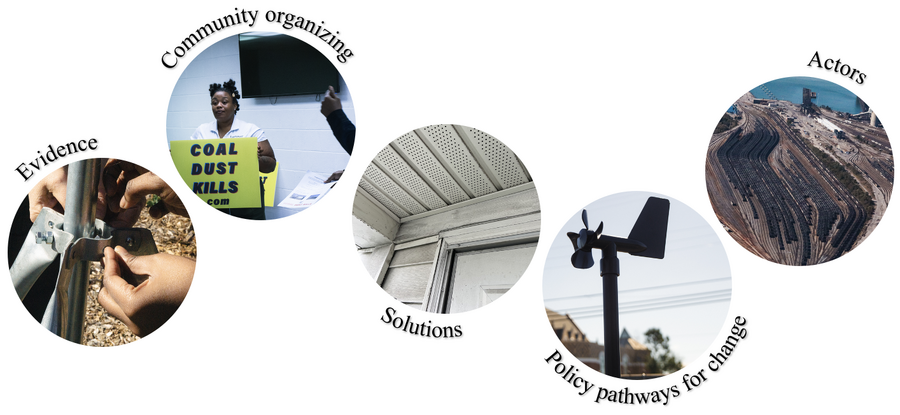Main Page: Difference between revisions
Jump to navigation
Jump to search
No edit summary |
No edit summary |
||
| Line 23: | Line 23: | ||
=== 1980s === | === 1980s === | ||
* | * Dust suppressing sprinkler systems are installed at coal terminals in response to community concerns. | ||
* A significant increase in formal complaints about coal dust from local residents, including the first recorded complaint from | * A significant increase in formal complaints about coal dust from local residents, including the first recorded complaint from Lambert's Point, Norfolk. | ||
* The Virginia Air Pollution Control Board begins monitoring coal dust emissions and takes initial steps to regulate coal dust control. | * The [[Regulatory Agencies#Virginia Air Pollution Control Board|Virginia Air Pollution Control Board]] begins monitoring coal dust emissions and takes initial steps to regulate coal dust control. | ||
=== 1990s === | === 1990s === | ||
* In 1990, the DEQ is formally established, | * In 1990, the [[Regulatory Agencies#Virginia Department of Environmental Quality (VA DEQ)|Virginia Department of Environmental Quality (VA DEQ)]] is formally established, with coal dust regulation becoming a priority issue. | ||
* Representative Dick Cranwell sponsors a bill requiring Norfolk Southern to report air quality and coal dust emissions. | * [[wikipedia:Richard_Cranwell#:~:text=Charles%20Richard%20%22Dick%22%20Cranwell%20(,the%20Democratic%20Party%20of%20Virginia.|Representative Dick Cranwell]] sponsors a bill requiring Norfolk Southern to report air quality and coal dust emissions. | ||
* The 1993 R.I.S.E. v. Kay lawsuit challenges a landfill siting in King and Queen County, citing environmental racism, which further shapes the conversation around environmental justice in Virginia. | * The 1993 R.I.S.E. v. Kay lawsuit challenges a landfill siting in King and Queen County, citing environmental racism, which further shapes the conversation around environmental justice in Virginia. | ||
Revision as of 00:51, 29 April 2025
Welcome to Voices in the Dust––a living community archive for action supporting current and future activists in the fight against coal dust pollution for environmental justice in Southeast Newport News and Lambert's Point, Norfolk.
Explore Voices in the Dust

Timeline of Key Events in Coal Dust Activism
1970s
- Jessie Radley, the first Black mayor of Newport News, and other local leaders begin early discussions around coal dust mitigation.
- Linwood DeBrew and other community members begin organizing around coal dust pollution issues.
- Formal complaints about coal dust are first reported at civic league meetings in the late 1970s and early 1980s.
1980s
- Dust suppressing sprinkler systems are installed at coal terminals in response to community concerns.
- A significant increase in formal complaints about coal dust from local residents, including the first recorded complaint from Lambert's Point, Norfolk.
- The Virginia Air Pollution Control Board begins monitoring coal dust emissions and takes initial steps to regulate coal dust control.
1990s
- In 1990, the Virginia Department of Environmental Quality (VA DEQ) is formally established, with coal dust regulation becoming a priority issue.
- Representative Dick Cranwell sponsors a bill requiring Norfolk Southern to report air quality and coal dust emissions.
- The 1993 R.I.S.E. v. Kay lawsuit challenges a landfill siting in King and Queen County, citing environmental racism, which further shapes the conversation around environmental justice in Virginia.
2000s
- The Southeast CARE Coalition, led by figures like Erica Holloman, Linwood DeBrew, and Angela Harris, intensifies organizing efforts around coal dust and environmental racism in Southeast Newport News.
- The coalition organizes public meetings, conducts health surveys, and advocates for improved air quality monitoring.
- In 2002, the Southeast CARE Coalition formally pushes for investigations into the health impacts of coal dust.
2010s
- The demolition of Harbor Homes and Dickerson Court in Newport News sparks debates about land use and environmental justice, with a push to address nearby brownfield sites.
- Increased activism around Lambert’s Point, led by the Sierra Club and supported by academic researchers like Dr. Anna Jeng from ODU, highlights the need for stronger air quality monitoring and regulatory measures.
- Planning grants are secured to explore solutions to coal dust impacts, and coal dust-related petitions are circulated.
2020s
- In 2020, the Virginia Environmental Justice Act is passed, with the state government committing to integrate EJ principles into decision-making.
- The TAME air monitoring program is launched to track coal dust levels in Lambert’s Point and Newport News.
- The Repair Lab begins work on a digital archive documenting decades of coal dust activism and EJ efforts in Virginia, providing a historical record of community struggles and victories.
Evidence
Community Activism and Concerns
Health Impacts: Particles and Coal Dust
Tidewater Air Monitoring Evaluation (TAME)
Organizing
Community Activism and Concerns
Solutions
Policy
Policy Pathways for Addressing Coal Dust Impacts
National Ambient Air Quality Standards (NAAQS)
Actors
Getting started
- Coaldustkills.com
- How do I use this wiki?
- How is this wiki is organized?
- How do edits get approved?